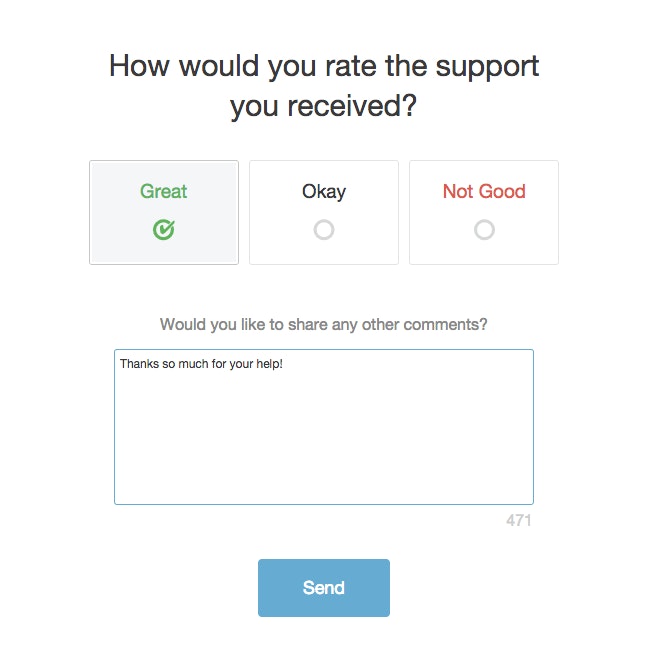The concept of a customer satisfaction score (CSAT) first gained recognition with the dawning of mass production. Movements such as Henry Ford's mass production of vehicles led to dramatic decreases in production cost and made the importance of individual customer experience much less critical.
These days, we've swung back the other direction. Even though mass production is still a norm, customers note the bounty of options at their fingertips and differentiate based on how satisfied they are with the product or service they're receiving.
CSAT, as we know it now, probably came about in 1994 when the University of Michigan established the American Customer Satisfaction Index (ACSI). It was the first measurement implemented to identify the value of goods and services from the perspective of the customer.
Modern CSAT still does just that: It takes an ongoing measurement of the overall satisfaction your customers have with a service, product, or relationship with your company.
What is customer satisfaction score?
Customer satisfaction score is a metric used by companies to understand how customers feel or how satisfied they are with a specific interaction or experience. Companies can measure after any occasion, but most often they use CSAT after:
Support interactions
Completing the sales process
Sales interactions
Setting up or using a product
Visiting a restaurant or location
Occasionally CSAT is used to measure more long-term relationships and isn't triggered by a specific action from the user. There are, however, other customer experience metrics that may be better suited to that.
CSAT is one of the three most popular metrics, the other two being Net Promoter Score (NPS) and Customer Effort Score (CES). Rather than picking one or the other or pitting them against each other, each metric has strengths and weaknesses.
One of CSAT's biggest criticisms is that a successful product or more revenue isn't usually correlated solely with happy customers. That's true! If customers are satisfied with the support or sales experience, they won't also automatically feel excited and invigorated by the product.
With that in mind, it's always best to view CSAT in tandem with other key metrics to find a correlation rather than view it in a silo. For instance, if you push a new process change in support and notice that your CSAT goes up, you can attribute some meaning to that.
When should you measure CSAT?
There's nothing to be lost by measuring CSAT, and most help desk software will have the functionality built in. That said, there are three times that you might choose to trigger a CSAT survey to a customer.
1. Right after a support interaction
Surveying directly after a support interaction can be done by including the survey right within the customer support representative's signature, as you can with Help Scout. You can also trigger an automatic CSAT email immediately after your team marks a conversation as closed.

By including the survey in the email signature, you keep the survey lightweight and low-pressure. On the other hand, sending the survey via automated email after the conversation is closed provides you with feedback on the entire interaction rather than each individual response.
Either way, it's a good idea to ask for feedback about an exchange soon after it is over. That way, the experience will be fresh in the customer's mind, and the response will be even more meaningful.
2. After a few interactions
If you have a business model that involves customers having multiple interactions with members of your support, sales, or customer success teams, it may be better to send a survey after a few interactions rather than after every reply.
You could send the CSAT survey, for example, after five interactions — or after a certain amount of time has passed since their last interaction.
3. Quarterly
Traditionally, CSAT is used to measure feedback with immediacy, but you can also measure satisfaction over time. If you would like to measure satisfaction over time, you can choose to send CSAT surveys quarterly.
Questions to ask to measure CSAT
No matter how frequently or infrequently you send your surveys, the question that you ask is important. Here are a few different ways to frame your ask to inform the types of answers you receive:
How satisfied are you with our email support?
How satisfied are you with our website experience?
How would you rate our event?
How pleased are you with our service?
How satisfied are you with your purchase?
Overall, how do you feel about our business?
How happy are you with this chat?
How pleased are you with the shopping experience?
How was your most recent visit?
How would you rate our newsletter?
Did we meet your expectations?
Remember, too, that you can ask multiple-choice questions, as is often the case with CSAT surveys, or you can offer open-ended options. Some companies choose to provide open-ended possibilities for customers to give a bit more insight into their survey.
Focusing on general questions about the business or expectations would be better for longer-term surveying, whereas more specific questions would be best for surveys sent immediately after an interaction.
How to calculate your customer satisfaction score
Your CSAT survey will ask a question regarding the customer's satisfaction with a specific interaction or service, and then the customer will be able to select an option between "satisfied" and "dissatisfied."
When considering your scale, take note that some customers feel confused when, for example, "1" means "good" and "5" means "bad." Many people associate a higher number with a positive score.
If you choose to structure your survey outside the norm, you may end up running into some incorrect data. For this reason, many companies choose to use emojis or some signifier other than numbers.
Your CSAT score will range from 0-100. To determine the score, you take the number of "satisfied" responses you receive and divide that by the total number of responses. Then, you multiply that by 100.

CSAT = (Number of positive responses / Number of total responses) x 100
So if you had 45 "satisfied" ratings out of 100 survey responses, your score would be 45.
CSAT vs. NPS
While CSAT is generally about satisfaction with a service or experience, Net Promoter Score (NPS) measures (customer loyalty](/customer-loyalty/). Specifically, NPS asks, "How likely are you to recommend [X) to your friends or family?" It directly addresses people's willingness to advertise your brand or product using word-of-mouth marketing.
While CSAT measures customer happiness, NPS measures your customer's desire to talk about and represent your brand.
Overall, NPS is a lagging indicator of business health — it's hard to move, and several smaller pieces go into making a solid NPS score. CSAT, however, is a leading indicator of both business health and perhaps even your NPS score. You'll notice your CSAT shifting before you see any more enormous, whole-business impacts.
Many people choose to measure NPS quarterly rather than after individual interactions. Some companies choose to use NPS in place of CSAT, though, to get similar pulse checks about unique processes.
Ultimately, it may be best to use both. The two metrics are complementary and answer different questions. Rather than deciding whether you use CSAT or NPS, determine instead which instances make sense for which survey, and use both.
There are a few reasons why using both of these complementary metrics can help your business:
While CSAT helps point out vital and specific areas or processes for improvement, NPS gives you an overall picture of customer loyalty. Use both together to map the clearest path to success.
CSAT is more versatile in that you can ask various questions, whereas NPS is a bit limited with its one-question structure.
Detractors aren't great in both cases, but an NPS detractor needs more immediate attention. They are explicitly referring to their willingness to talk about your brand and may already speak negatively about your product in public.
CSAT is better to pinpoint specific areas of customer interest, whereas NPS helps you measure brand perception as a whole.
Determine which cadence makes the most sense for your business, and consider using both survey types to have the most perspective on customer feelings and needs.
What do you do with CSAT?
Now that you know all the ins and outs of CSAT, it's time to put it into practice. While CSAT is excellent for getting to know how your customers are feeling, there are many other practical applications for this versatile metric.
Close the loop with your customers
Responding to CSAT surveys from customers who provided neutral or low ratings allows you to build more rapport with potentially disengaged customers. Asking for more information or starting up a conversation shows them that you care about what they think and feel and also allows you to get valuable intel to improve your product.
Share knowledge with outside teams
There is no better evidence than hearing something right out of the horse's mouth. Use CSAT responses to help bolster your case for specific product changes or bug fixes.
Beyond that, hearing things from the customer's perspective helps increase your team’s understanding when creating things like customer journey maps, marketing strategies, and even product roadmaps. CSAT is one of the best ways to distill those insights.
Improve processes
CSAT is a great way to pinpoint individual areas of improvement. If you use CSAT over every interaction, you can compare CSAT scores for different channels, team members, and even various times of the day.
Doubling up this data with in-app user information can help to make it even more insightful. Pay attention to these comparisons, and they'll point out key areas of improvement within your support or product processes.
Track it over time
Tracking CSAT over time gives you a unique insight into how your team is doing. Has your CSAT gone up over the past year? Down?
Using this more long-term measurement helps to give a bit of perspective into whether your overall strategy is working or not. For instance, if it's been steadily going down, something should probably change.
Compare it to other metrics
No data should live in a silo. Use CSAT to add some additional color to your other metrics: For instance, compare CSAT with first response time and then loop that in with retention.
This type of comparison creates a more multifaceted representation of each metric and the story you're trying to tell by using them all together!
Get to know your customers
Having a deeper understanding of your customers’ satisfaction is an essential first step to creating a holistically excellent customer experience. Measuring CSAT, whether right after an interaction or quarterly over time, can help you get critical insights into how your processes, products, or exchanges make your customers feel.
But don't view CSAT in a silo. Link CSAT to things like first contact resolution or customer effort score to see how shifts to your strategy affect your customers' sentiments, and compare it to other key business metrics to get a full perspective of how your customers are feeling and why.








